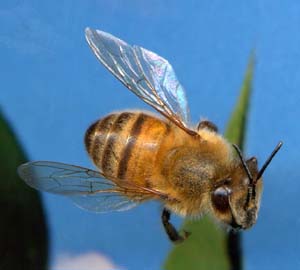Queen Succession in Honeybees Biology 342 Fall 07
by Laura Mulshine and Alice Runckel
Queen Succession in Honeybees

http://chat.carleton.ca/~hcampbe3/honeybee-1.jpg (Oct. 9, 2007)
References
Breed M.D., and Gamboa G.J. (1977) Behavioral control of workers by queens in primitively eusocial bees, Science, 195, 694-696.
Evans J. D. and Wheeler D.E. (1999) Differential gene expression between developing queens and workers in the honey bee, Apis mellifera, Proceedings of the National Academy of Sciences of the United States of America, 96, 5575-5580.
Gary, N. E. (1961) Queen honey bee attractiveness as related to mandibular gland secretion, Science, 133, 1479-1480.
Gary N. E. (1962) Chemical mating attractants in the queen honeybee, Science, 136, 771-774.
Hambleton J. I. (1934) Bee behavior, The Scientific Monthly, 39, 544-546.
Keeling C.I., Slessor, K.N., Higo H.A., and Winston M.L. (2003) New components of the honey bee (Apis mellifera L.) queen retinue pheromone, Proceedings of the National Academy of Sciences of the United States of America, 100, 4486-4491.
Michener C.D. and Brothers D.J. (1974) Were workers of eusocial hymenoptera initially altruistic or oppressed, Proceedings of the National Academy of Sciences of the United States of America, 71, 671-674.
Morse R.A. (1963) Swarm orientation in honeybees, Science, 141, 357-358.
Pettis J. S., Collins A. M., Wilbanks R., and Feldlaufer M.F. (2004) Effects of coumaphos on queen rearing in the honey bee, Apis mellifera, Apidologie,35, 605-610.
Pirk C.W.W., Neumann P., Hepburn R., Moritz R.F.A., Tautz J., and Lindauer M. (2004) Proceedings of the National Academy of Sciences of the United States of America, 101, 8649-8651.
Tarpy D.R., and Fletcher D. J.C (1998) Effects of relatedness on queen competition within honey bee colonies, Animal Behavior, 55,537-543.
Tarpy D.R., Hatch S., and Fletcher D. J.C (2000) Influence of Queen age and quality during queen replacement in honeybee colonies, Animal Behavior, 59, 97-101.
Tinbergen N. (2005) On aims and methods of ethology, Animal Biology, 55, 297-231.
Thompson C.B. (1918) Dual queens in a colony of honey bees, Science, 48, 294-295.
Tofiliski A., and Czekonska K. (2004) Emergency queen rearing in honeybee colonies with brood of known age, Apidologie. 35, 275-282.
USDA data was taken from http://www.ars.usda.gov/Research/docs.htm?docid=11059 on October 20, 2007.
All photos were taken from websited in October 2007.
For more information look at the following websites.
http://www.ento.vt.edu/apiculture/
http://www.ucmp.berkeley.edu/arthropoda/uniramia/hymenoptera.html
http://beesource.com/pov/ahb/ahbarizona.htm
http://www.ars.usda.gov/Services/docs.htm?docid=2744&page=12